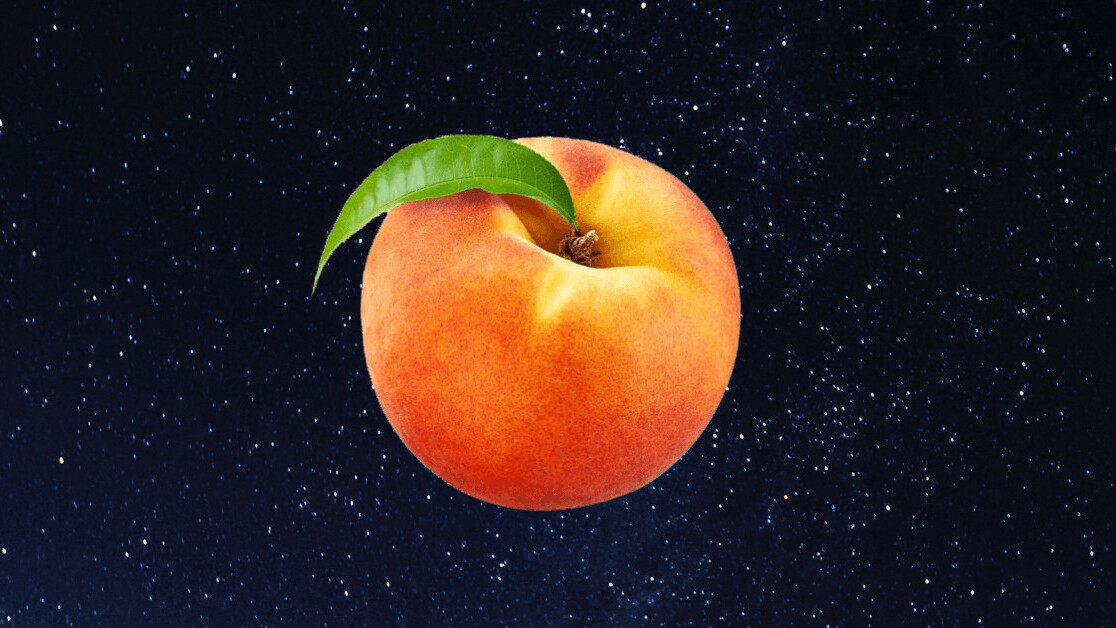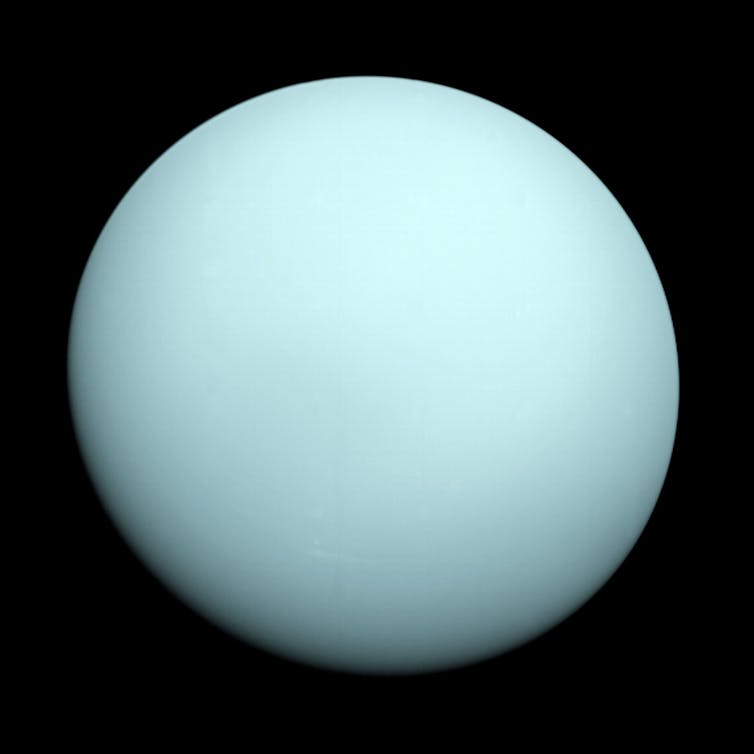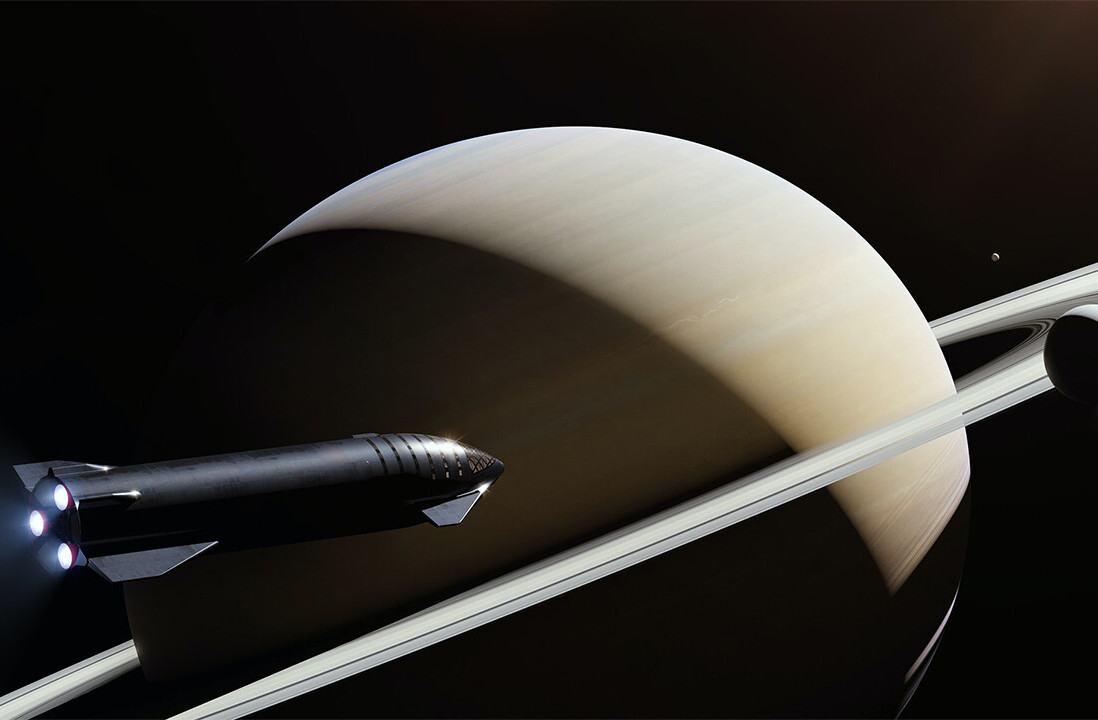
Uranus is arguably the most mysterious planet in the solar system – we know very little about it. So far, we have only visited the planet once, with the Voyager 2 spacecraft back in 1986. The most obvious odd thing about this ice giant is the fact that it is spinning on its side.
Unlike all the other planets, which spin roughly “upright” with their spin axes at close to right angles to their orbits around the sun, Uranus is tilted by almost a right angle. So in its summer, the north pole points almost directly towards the sun. And unlike Saturn, Jupiter, and Neptune, which have horizontal sets of rings around them, Uranus has vertical rings and moons that orbit around its tilted equator.
The ice giant also has a surprisingly cold temperature and a messy and off-centre magnetic field, unlike the neat bar-magnet shape of most other planets like Earth or Jupiter. Scientists therefore suspect that Uranus was once similar to the other planets in the solar system but was suddenly flipped over. So what happened? Our new research, published in the Astrophysical Journal and presented at a meeting of the American Geophysical Union, offers a clue.
Cataclysmic collision
Our solar system used to be a much more violent place, with protoplanets (bodies developing to become planets) colliding in violent giant impacts that helped create the worlds we see today. Most researchers believe that Uranus’ spin is the consequence of a dramatic collision. We set out to uncover how it could have happened.
We wanted to study giant impacts on Uranus to see exactly how such a collision could have affected the planet’s evolution. Unfortunately, we can’t (yet) build two planets in a lab and smash them together to see what really happens. Instead, we ran computer models simulating the events using a powerful supercomputer as the next best thing.
The basic idea was to model the colliding planets with millions of particles in the computer, each representing a lump of planetary material. We give the simulation the equations that describe how physics like gravity and material pressure work, so it can calculate how the particles evolve with time as they crash into each other. This way we can study even the fantastically complicated and messy results of a giant impact. Another benefit of using computer simulations is that we have full control. We can test a wide variety of different impact scenarios and explore the range of possible outcomes.
Our simulations (see above) show that a body at least twice as massive as the Earth could readily create the strange spin Uranus has today by slamming into and merging with a young planet. For more grazing collisions, the impacting body’s material would probably end up spread out in a thin, hot shell near the edge of Uranus’ ice layer, underneath the hydrogen and helium atmosphere.
This could inhibit the mixing of material inside Uranus, trapping the heat from its formation deep inside. Excitingly, this idea seems to fit with the observation that Uranus’ exterior is so cold today. Thermal evolution is very complicated, but it is at least clear how a giant impact can reshape a planet both inside and out.
Super computations
The research is also exciting from a computational perspective. Much like the size of a telescope, the number of particles in a simulation limits what we can resolve and study. However, simply trying to use more particles to enable new discoveries is a serious computational challenge, meaning it takes a long time even on a powerful computer.
Our latest simulations use over 100m particles, about 100-1,000 times more than most other studies today use. As well as making for some stunning pictures and animations of how the giant impact happened, this opens up all sorts of new science questions we can now begin to tackle.
This improvement is thanks to SWIFT, a new simulation code we designed to take full advantage of contemporary “supercomputers”. These are basically lots of normal computers linked up together. So, running a big simulation quickly relies on dividing up the calculations between all parts of the supercomputer.
SWIFT estimates how long each computing task in the simulation will take and tries to carefully share the work evenly for maximum efficiency. Just like a big new telescope, this jump to 1,000 times higher resolution reveals details we have never seen before.
Exoplanets and beyond
As well as learning more about the specific history of Uranus, another important motivation is understanding planet formation more generally. In recent years, we have discovered that the most common type of exoplanets (planets that orbit stars other than our sun) are quite similar to Uranus and Neptune. So everything we learn about the possible evolution of our own ice giants feeds in to our understanding of their far distant cousins and the evolution of potentially habitable worlds.
One exciting detail we studied that is very relevant to the question of extraterrestrial life is the fate of an atmosphere after a giant impact. Our high resolution simulations reveal that some of the atmosphere that survives the initial collision can still be removed by the subsequent violent bulging of the planet.
The lack of an atmosphere makes a planet a lot less likely to host life. Then again, perhaps the massive energy input and added material might help create useful chemicals for life as well. Rocky material from the impacting body’s core can also get mixed into the outer atmosphere. This means we can look for certain trace elements which might be indicators of similar impacts if we observe them in an exoplanet’s atmosphere.
Lots of questions remain about Uranus, and giant impacts in general. Even though our simulations are getting more detailed, we still have lots to learn. Many people are therefore calling for a new mission to Uranus and Neptune to study their strange magnetic fields, their quirky families of moons and rings and even simply what precisely they’re actually made of.
I would very much like to see that happen. The combination of observations, theoretical models and computer simulations will ultimately help us understand not only Uranus, but the myriad planets that fill our universe and how they came to be.![]()
This article is republished from The Conversation by Jacob Kegerreis, PhD Student, Computational Astronomy, Durham University under a Creative Commons license. Read the original article.
Get the TNW newsletter
Get the most important tech news in your inbox each week.





